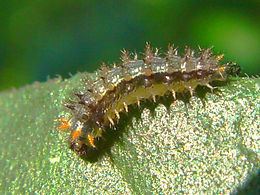

Anthanassa frisia, Cuban Crescent
All photographs are copywrited property. Please contact us for permission to use.

Freshly emerged female
Description: 14-21 mm. Adults are bright orange with dark brown outer margins and markings inside. In the dark brown tips of the forewing, there are a series of orange spots (yellow in females). The outer margin of the forewing is slightly scalloped which helps differentiate it from other crescents. Ventrally, this species is mottled brown with an orange patch on the forewing.
Habitat and Distribution: Hammock edges and weedy fields in the Caribbean. It is established in southernmost Dade County, but is very rare on the Florida mainland. There were a number of years in the 1990's when this species was not seen. We found a colony on West Summerland Key in 2003. It was there for several years but after only two years, the colony seemed to no longer be present. It has been reported from just about every Key and in every month.
Host Plant: Dicliptera assurgens
Natural History: This species seems to temprarily take up residency in weedy areas where its host plant is present but colonies do not seem to stick around for long periods of tiime. From our experience this species is rare but when colonies are found they are abundant. Larvae can easily be reared in large numbers on exotic ornamental "shrimp plant".

Egg cluster

1st instar larval
cluster "scraping" leaves

Final instar larva
feeding on shrimp plant

Final instar larva

Freshly emerged male

Freshly emerged female


Chryslis

Freshly emerged female
Freshly emerged male

Habitat for colony on West Summerland Key
Flip Through
Species Pages